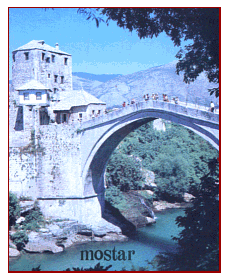|
Mostar


 |
|
Mostar
Founded in the late 15th century, Mostar was the chief administrative
city for the Ottoman Empire in the Herzegovina region. The
Austro-Hungarian Empire absorbed Mostar in 1878 and then it became part
of Yugoslavia in the aftermath of World War I.
After World War II, Mostar developed a production of tobacco, bauxite,
wine and aluminium products. Several dams ("Grabovica", "Salakovac",
"Mostar") were built in the region to harness the hydroelectric power of
the Neretva.
Its history may seem at first glance little different than other cities
in the region. Illyrians, Romans, Goths, Slavs, Turks, and Austrians all
laid claim to the area at one time or another. What made Mostar unique
was that it developed into one of the most multi-ethnic cities in the
Balkans.
Mostar is a city of 75,613 (1991) in Bosnia and Herzegovina, the center
of the Herzegovina-Neretva Canton of the Federation.
The unofficial capital of Herzegovina, Mostar is situated on the Neretva
river. Mostar has an international airport, located in the nearby
village of Ortiješ.
Mostar was named after its Old Bridge (Stari most) and the towers on its
sides, "the bridge keepers" (mostars in Bosnian/Croatian).
|
 |